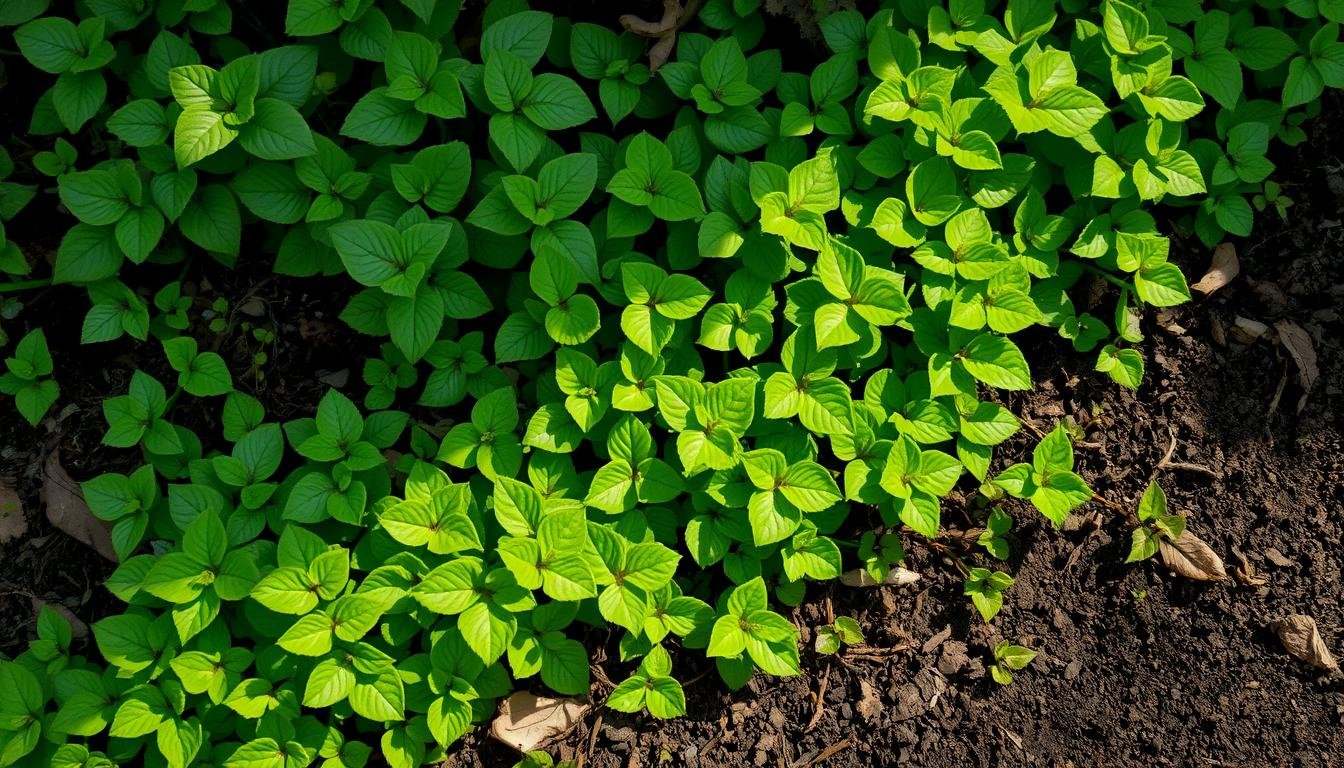The creeping Charlie plant, also known as Glechoma hederacea, is a great choice for gardens. It’s known as ground ivy or catsfoot. This plant is tough and can grow well in many places, making it a good pick for easy-to-care-for gardens. But, it can become a problem if it spreads too much.
The creeping Charlie plant loves moist, shady spots and can handle some sun. Its purple flowers in spring and summer are beautiful and attract bees and butterflies. This guide will help you understand and manage this interesting plant in your garden.
Table of Contents
Introduction to Creeping Charlie Plant
The creeping charlie plant, also known as ground ivy, has invaded North American gardens for over a century. It was first brought for its beauty and medicinal uses. Now, it’s a challenge to manage in gardens and lawns.
This plant thrives in wet, shaded spots. It grows into dense mats, spreading up to 3 feet wide and 1 foot tall. Its growth can quickly take over your garden.
Creeping charlie’s leaves are rounded and have scalloped edges. They have palmate veins, making them stand out. The plant’s purple or blue flowers bloom in clusters, adding charm but also posing a problem.
Its dense foliage can make your garden look good. But, it’s important to understand its invasive side. This plant spreads through stolons and can produce up to four seeds per flower.
It prefers poor soil, which makes it appealing to eco-friendly gardeners. Yet, finding a balance between its benefits and its invasive nature is key.
What is Creeping Charlie?
Creeping Charlie, also known as Glechoma hederacea, is a unique perennial plant. It belongs to the mint family, Lamiaceae. It came from Europe and arrived in the United States in 1672.
People call it ground ivy because of its aggressive growth. It’s also valued for its use in cooking and medicine.
Scientific Classification
Creeping Charlie falls under the genus Glechoma in the mint family. This group includes plants known for their scent. It shows the plant’s uses in cooking and traditional medicine.
Growth Characteristics
This perennial plant has distinct growth traits. Creeping Charlie has:
- Square stems that make it stand out.
- Kidney-shaped leaves with scalloped edges, giving it a unique look.
- Bluish-purple funnel-shaped flowers that bloom in clusters from April to June, making gardens beautiful.
It loves moist, shaded areas but can also grow in sunny spots. It spreads quickly through seeds, rhizomes, and stems. This makes it an invasive weed. Gardeners need to manage its growth to keep their gardens healthy and balanced.
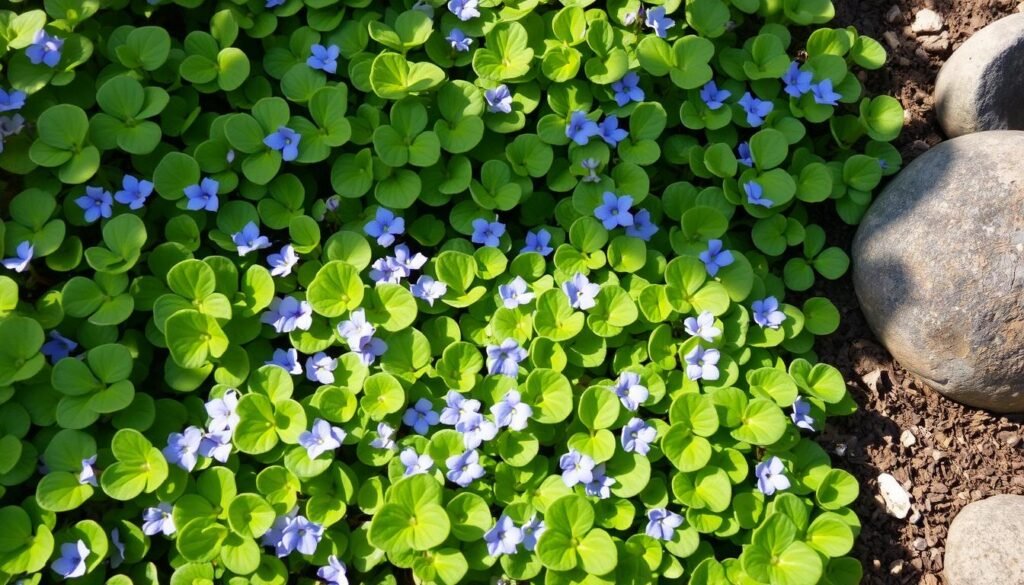
Benefits of Creeping Charlie as Ground Cover
Creeping Charlie is a great choice for garden ground cover. It’s perfect for those who want something easy to care for. This plant loves shade and grows well in spots where grass doesn’t.
It’s great for gardens that need a little extra help. Creeping Charlie is easy to grow and looks good all year.
Shade Tolerance
This plant is perfect for shady spots. It does well under trees or near buildings. Unlike regular grass, it keeps growing even in less light.
This means your garden stays green and healthy, even in the shade.
Low Maintenance Requirements
Adding creeping Charlie to your garden is easy. It doesn’t need to be mowed often. This saves you time and helps the environment.
With creeping Charlie, your garden looks great without all the work. It’s a low-maintenance way to keep your garden beautiful.
Soil Erosion Control
Creeping Charlie’s thick growth helps prevent soil erosion. Its roots hold the soil in place. This is great for areas where water can wash away the soil.
It keeps your garden stable and beautiful. Creeping Charlie makes your garden stronger and more resilient.
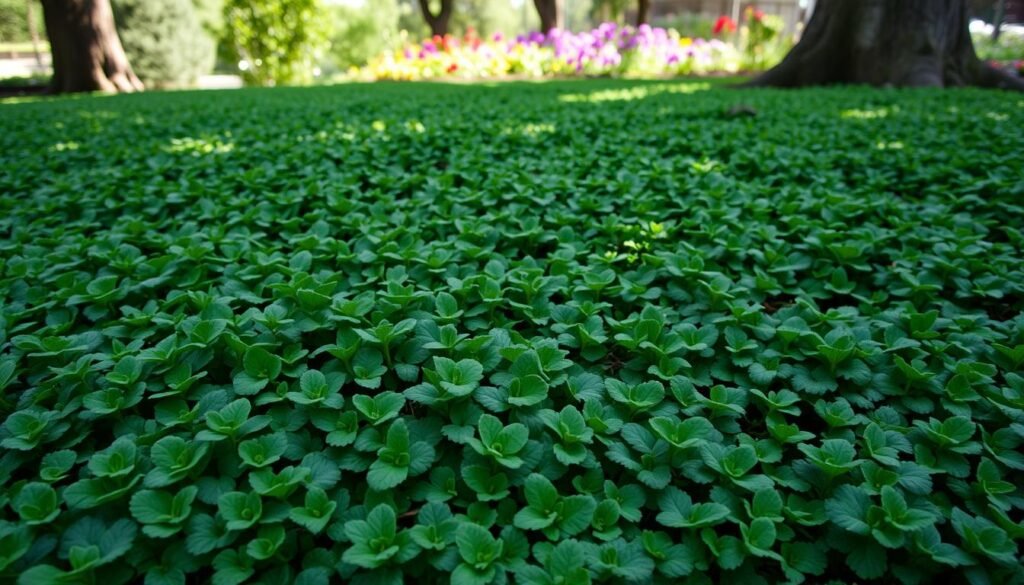
Creeping Charlie Plant: A Double-Edged Sword
The creeping charlie plant is both a blessing and a curse for gardeners. Knowing its two sides helps you manage its growth. This way, you can use garden management strategies effectively.
Advantages for Gardeners
Creeping Charlie has many advantages for gardeners. It grows well in tough spots, making shaded areas look lush. Its flowers make gardens look better and attract helpful insects.
It also adds a special taste to food when picked right.
Disadvantages and Invasive Nature
The creeping charlie plant’s invasive nature is a big problem. It grows too fast and takes over other plants. This makes it hard to keep it under control.
It can turn from a nice addition to a garden problem. So, it’s important to find ways to stop it from spreading too much.
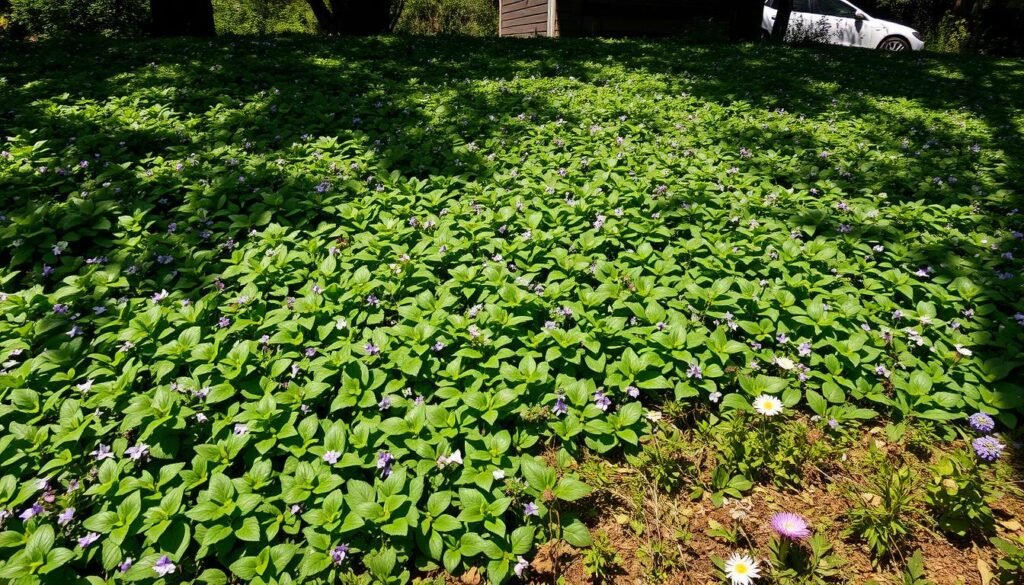
Identifying Creeping Charlie
Knowing how to spot creeping Charlie is key to keeping your garden weed-free. This plant, known as Glechoma hederacea, has unique features. Its stems are square, and its leaves are glossy green, 2 to 5 cm wide, with scalloped edges. The leaves often turn purplish in sunlight.
In spring and early summer, it blooms with clusters of blue-purple flowers. These flowers grow in whorls along the stem, with two or three blooms together. This helps you tell it apart from other weeds like creeping Jenny.
Creeping Charlie grows low to the ground, spreading quickly. Its shallow roots make it hard to manage. Each leaf stem node can root if it touches the soil. Knowing these traits is important for a healthy garden and lawn.
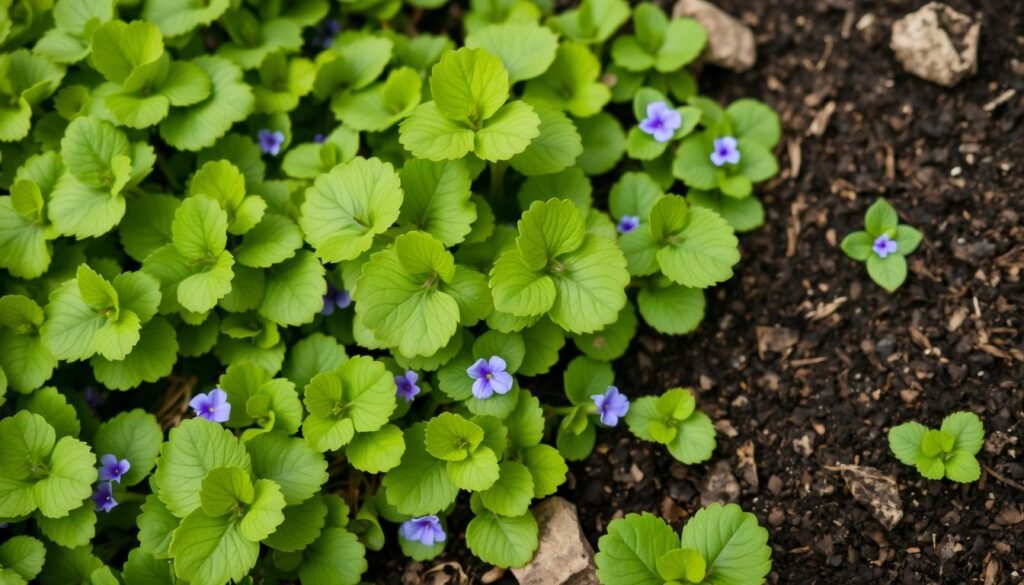
| Characteristic | Description |
|---|---|
| Height | Can grow up to 30 cm (12 inches) |
| Leaves | Glossy green, 2-5 cm across, scalloped edges, square stems |
| Flowers | Blue to blue-violet color, 1/3 to 3/4 inch long, tubular shape |
| Growth Habit | Low, creeping nature with rooting at nodes |
| Preferred Habitat | Moist, shaded areas but can adapt to full sun |
Learning to identify creeping Charlie helps you manage it effectively. By knowing how to spot it, you can protect your garden. This ensures your plants thrive in a healthy environment. For more tips, check out this guide on growing hydroponic plants.
How to Care for Creeping Charlie in Your Garden
Knowing how to care for creeping charlie is key to a healthy garden. This plant does well in many conditions, making it a favorite among gardeners. To keep your creeping charlie looking good, follow the right watering, soil, and sunlight tips.
Watering and Soil Conditions
Creeping Charlie loves moist, well-draining soil. It needs regular watering, about 0.5 cups every 9 days in a 5″ pot without direct sunlight. Too much water can cause yellow leaves and root rot. Use a peat-based soil mix to keep the soil moist but not soggy.
Sunlight Requirements
This plant does best in partial shade but can handle bright indirect light. It should get around 6 hours of filtered sunlight each day. Placing it within 3 feet of a south-facing window indoors boosts its growth. This careful planning helps your creeping Charlie thrive and might even help your garden. For more tips on caring for creeping Charlie, click here.
| Care Aspect | Requirement |
|---|---|
| Watering | 0.5 cups every 9 days |
| Soil Type | Peat-based, well-draining |
| Sunlight | 6 hours of filtered bright light |
| Growth Potencial | Less than 3 feet from a south-facing window |
Getting Rid of Creeping Charlie
Creeping Charlie, also known as Glechoma hederaceae, is a tough garden foe. There are many ways to fight it, from pulling it by hand to using herbicides. Knowing your options helps you pick the best method for your garden.
Hand-Pulling Methods
Hand-pulling is a simple way to get rid of creeping charlie. It works well for small areas, as it doesn’t use chemicals. Wetting the soil first makes pulling the roots out easier.
But, this method takes time and effort. You might need to pull it several times to get rid of it all.
Using Herbicides Safely
For bigger areas, using herbicides is often needed. Look for broadleaf herbicides like dicamba or 2,4-D. They target creeping charlie without harming other plants.
Always follow the herbicide’s instructions carefully. This ensures you use it safely and effectively. It also helps protect your garden’s other plants.
Organic Treatment Options
For those who prefer organic solutions, there are options. Borax is sometimes used, but be careful as it can harm soil and plants. A mix of dish soap, Epsom salt, and vinegar is also effective. It dries out the plant.
Trying these organic methods lets you garden in a way that’s good for the environment. It helps control invasive plants like creeping charlie.
| Method | Effectiveness | Environmentally Friendly | Labor Intensity |
|---|---|---|---|
| Hand-Pulling | Moderate | Yes | High |
| Herbicide Application | High | No | Low |
| Organic Herbicides | Moderate | Yes | Medium |
Keep an eye on your garden to stop creeping charlie from coming back. By using these methods, you can keep your garden free from this invasive plant.
Propagation Techniques for Creeping Charlie
Learning how to propagate Creeping Charlie can really help your garden grow. By using the right techniques, you can add more plants to your garden. This makes your garden look beautiful and healthy.
Methods of Propagation
There are many ways to propagate Creeping Charlie, depending on what you like. The most popular methods are:
- Stem Cuttings: Take healthy stem parts and plant them in good soil.
- Division: Split big plants into smaller ones, each can grow into a new plant.
- Layering: Bend a stem down and pin it to the ground. Roots will grow while it’s attached.
For more info on these methods of propagation, check out the guide. Each method can lead to great results, making your garden look and feel better.
Timing for Successful Growth
When you start propagating Creeping Charlie is very important. The best time is in spring or early summer. This is when the plant grows the most.
Choosing the right time helps your plants grow strong and healthy. It makes sure your Creeping Charlie plants do well.
Preventing Creeping Charlie from Taking Over
To keep your garden free from creeping Charlie, focus on a competitive lawn and good soil health. These steps help stop this weed from spreading in your yard.
Creating a Competitive Lawn
A strong lawn is your first defense against creeping Charlie. By managing your lawn well, you can keep this weed from growing. Here are some tips to make your lawn stronger:
- Regular mowing at the right height makes grass stronger.
- Overseeding helps grow thicker grass, filling in bare spots where weeds can grow.
- Using a fertilization schedule keeps your grass healthy.
- Don’t overwater, as creeping Charlie loves moist soil.
Maintaining Soil Health
Good soil health is key to keeping creeping Charlie away. Here are ways to improve your soil:
- Improve drainage to keep soil dry, making it hard for creeping Charlie to grow.
- Test your soil to see if it needs nutrients and add them if needed.
- Prune trees to let more sunlight reach your lawn, helping it grow better.
- Manage water in shaded areas to keep the soil dry.
Using overseeding and careful fertilizing can help control creeping Charlie.
| Practice | Benefit |
|---|---|
| Overseeding | Encourages denser grass coverage |
| Regular mowing | Strengthens grass health and deters weeds |
| Soil drainage improvement | Reduces moisture content, limiting creeping Charlie’s growth |
| Soil testing and amendment | Ensures optimal nutrient levels for grass |
| Pruning for sunlight | Maximizes grass growth |
By following these steps, you can manage your lawn well. This helps prevent creeping Charlie and keeps your yard looking great.
Conclusion
The Creeping Charlie plant, or Glechoma hederacea, is a unique addition to gardens. It offers benefits and challenges to gardeners. Its ability to cover the ground well but grow aggressively makes it tricky to handle.
Knowing how to manage Creeping Charlie is key. This helps you enjoy its good sides while controlling its invasive traits. It’s all about finding the right balance.
Using different gardening methods can help keep your garden healthy. For example, organic treatments and careful hand-pulling can reduce its impact. Also, its uses in medicine and cooking can turn it into a valuable part of your garden.
Understanding Creeping Charlie’s dual nature helps you decide its role in your garden. By actively managing invasive plants, you can benefit from its many advantages. This includes its ability to cover the ground and support local pollinators. For more tips on managing Creeping Charlie, check out the detailed guide here.

